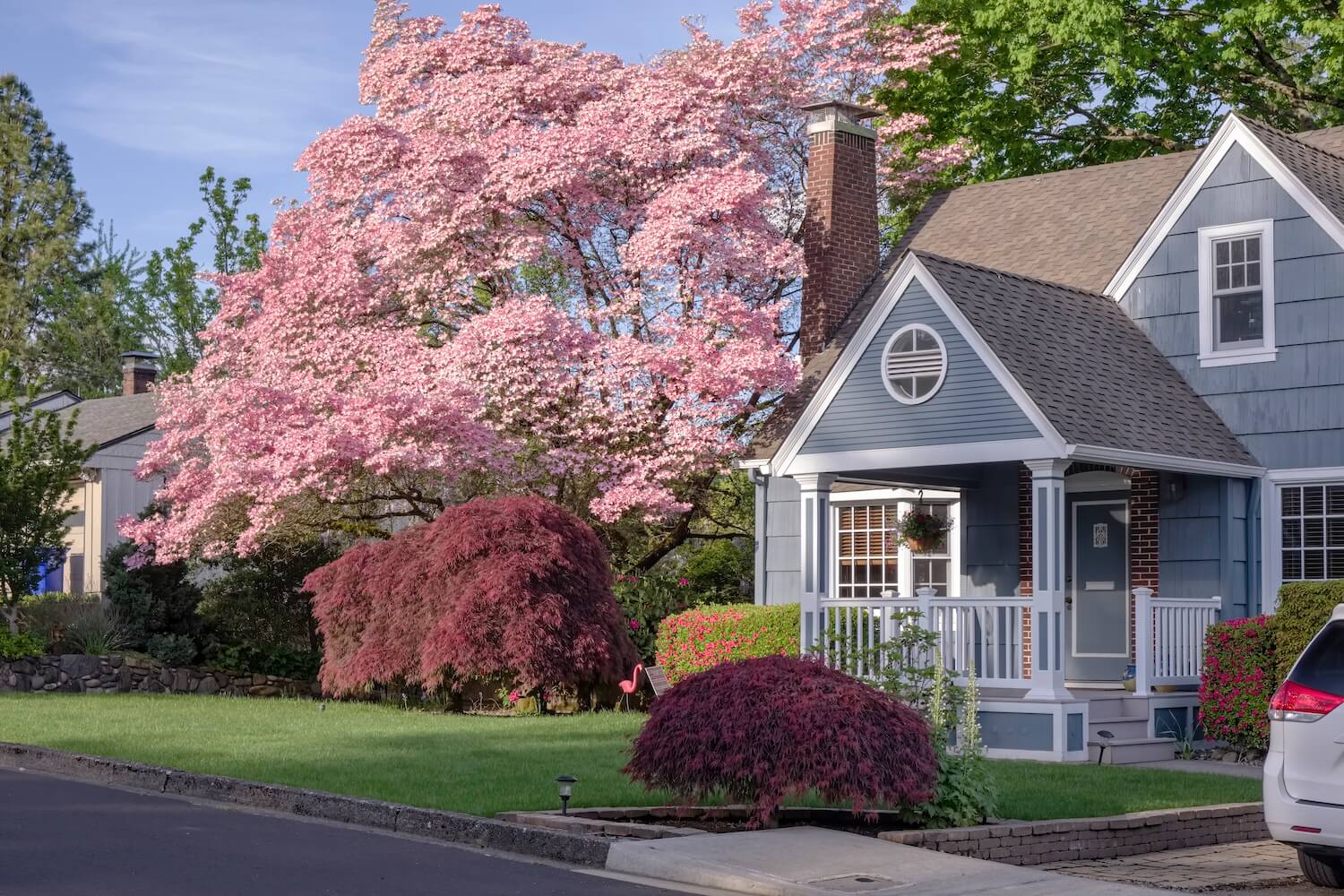Spring is a season of rejuvenation and renewal, making it the perfect time to address the maintenance needs of your home’s roofing system. In Eugene, Oregon, where the Pacific Northwest’s unique climate can take a toll on roofs, proactive maintenance is essential to ensure longevity and prevent costly repairs down the line.
This comprehensive roofing maintenance checklist will guide Eugene homeowners through the essential steps to prepare their roofs for the spring season.

1. Visual Roof Inspection
Start your spring roof maintenance by conducting a thorough visual inspection from the ground. Look for the following signs of home damage or wear:
- Missing or Damaged Shingles: Check for any shingles that are cracked, curled, or missing altogether. These can leave your roof vulnerable to water damage and should be replaced promptly.
- Moss and Algae Growth: Eugene’s damp climate can encourage the growth of moss, algae, and mildew on your roof. Not only are these growths unsightly, but they can also trap moisture and cause shingles to deteriorate over time.
- Flashing Damage: Inspect the metal flashing around chimneys, vents, and skylights for signs of rust, corrosion, or damage. Damaged flashing can lead to leaks and should be repaired or replaced as needed.
2. Clean Gutters and Downspouts
Clogged gutters and downspouts can cause water to back up and overflow, leading to water damage to your roof and home’s foundation. Clean out any leaves, twigs, and other debris from your gutters and ensure that downspouts are directing water away from your home’s foundation.
3. Trim Overhanging Branches
Overhanging tree branches can scrape against your roof, causing damage to shingles and potentially allowing pests to access your home. Trim back any branches that are within six feet of your roof to prevent damage and maintain proper ventilation.
4. Check Attic Ventilation
Proper attic ventilation is essential for regulating temperature and moisture levels in your home, which can extend the life of your roof. Check your attic vents for blockages or damage and ensure that they are providing adequate airflow.
5. Inspect Skylights and Chimneys
Skylights and chimneys are common sources of leaks and should be inspected for signs of damage or wear. Check the seals around skylights and the flashing around chimneys for cracks, gaps, or other issues that could lead to water infiltration.
6. Test for Roof Water Leaks
After completing your visual inspection, perform a water test to check for any hidden leaks. Using a garden hose, spray water on different sections of your roof while someone checks the attic for signs of water infiltration. Pay special attention to areas around vents, chimneys, and skylights, as these are common leak-prone areas.
7. Schedule Professional Roof Inspection
While DIY inspections are beneficial, it’s also a good idea to schedule a professional roof inspection at least once a year. A qualified roofing contractor can identify potential issues that may not be visible to the untrained eye and provide recommendations for necessary repairs or maintenance.
8. Consider Roof Repairs or Roof Replacement
Based on your inspection and the recommendations of a professional roofer, determine if any repairs or a full roof replacement are necessary. Spring is an ideal time for roofing projects in Eugene, as the weather is generally mild, and contractors are less likely to be booked up compared to the busy summer months.
9. Invest in Roof Protection
To extend the life of your home roof and minimize home maintenance needs, consider investing in roof protection products such as:
- Roof Coatings: A reflective roof coating can help to reduce heat absorption, lower cooling costs, and prolong the life of your roofing materials.
- Gutter Guards: Installing gutter guards can prevent debris from accumulating in your gutters, reducing the frequency of cleanings and potential water damage.
10. Create a Regular Roof Maintenance Schedule
Once you’ve completed your spring roofing maintenance, create a regular maintenance schedule to keep your roof in optimal condition throughout the year. Regular inspections and minor repairs can prevent larger issues from developing and extend the lifespan of your roof.
The Importance of Regular Roof Maintenance
Beyond the immediate benefits of preventing damage and prolonging the life of your roof, regular maintenance offers Eugene homeowners several long-term advantages. First and foremost, a well-maintained roof enhances your home’s curb appeal and overall value. A roof in good condition can significantly boost your home’s resale value and make it more attractive to potential buyers should you decide to sell in the future.
Additionally, regular roof maintenance can save you money on energy bills. A properly ventilated and insulated roof helps to regulate the temperature inside your home, reducing the strain on your heating and cooling systems. This not only lowers your monthly utility costs but also reduces your home’s carbon footprint, making it more environmentally friendly.
Furthermore, proactive roof maintenance can help you avoid the stress and inconvenience of emergency repairs. By addressing issues early on, you can schedule repairs at your convenience and avoid the hassle of dealing with unexpected leaks or structural damage. This can also save you money in the long run by allowing you to budget for necessary repairs rather than facing costly emergency expenses.
The Role of Professional Roofers
While many homeowners are capable of performing basic roof maintenance tasks, some tasks require the expertise and specialized equipment of professional roofers. Professional roofers have the knowledge and experience to identify potential issues that may be overlooked during a DIY inspection and can provide expert recommendations for repairs or replacements.
When hiring a roofing contractor, it’s essential to choose a reputable company with a proven track record of quality workmanship and customer satisfaction. Look for contractors who are licensed, insured, and certified by reputable industry organizations. Additionally, ask for references and read online reviews to ensure that you’re hiring a reliable and trustworthy professional.
Roofing Materials and Sustainability
When considering roof maintenance and replacement options, Eugene homeowners should also take into account the sustainability of roofing materials. Sustainable roofing materials, such as metal, tile, and certain types of asphalt shingles, are not only environmentally friendly but also durable and energy-efficient.
Metal roofing, for example, is highly durable and can last up to 50 years with proper maintenance. Additionally, metal roofs are recyclable at the end of their lifespan, making them an eco-friendly option. Tile roofing is another sustainable choice, as clay and concrete tiles are made from natural materials and can last for decades with minimal maintenance.
Asphalt shingles, while not as long-lasting as metal or tile, can be made from recycled materials and are recyclable themselves, making them a greener alternative to traditional asphalt shingles. Furthermore, some asphalt shingles are designed to reflect more sunlight, reducing heat absorption and lowering cooling costs.
Conclusion
Proactive roof maintenance is key to ensuring the longevity and performance of your Eugene, OR home. By following this comprehensive roofing maintenance checklist, Eugene homeowners can identify and address potential issues before they escalate into costly repairs or replacements. Whether you tackle these tasks yourself or enlist the help of a professional roofing contractor, taking the time to care for your roof this spring will pay off in the long run with a safer, more comfortable, and more energy-efficient home.










